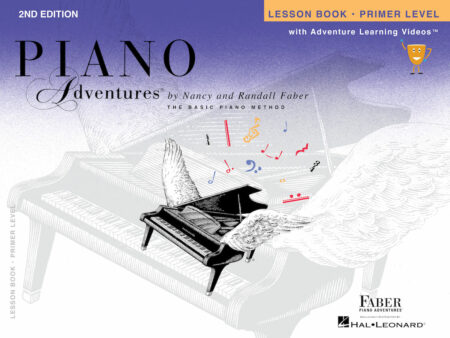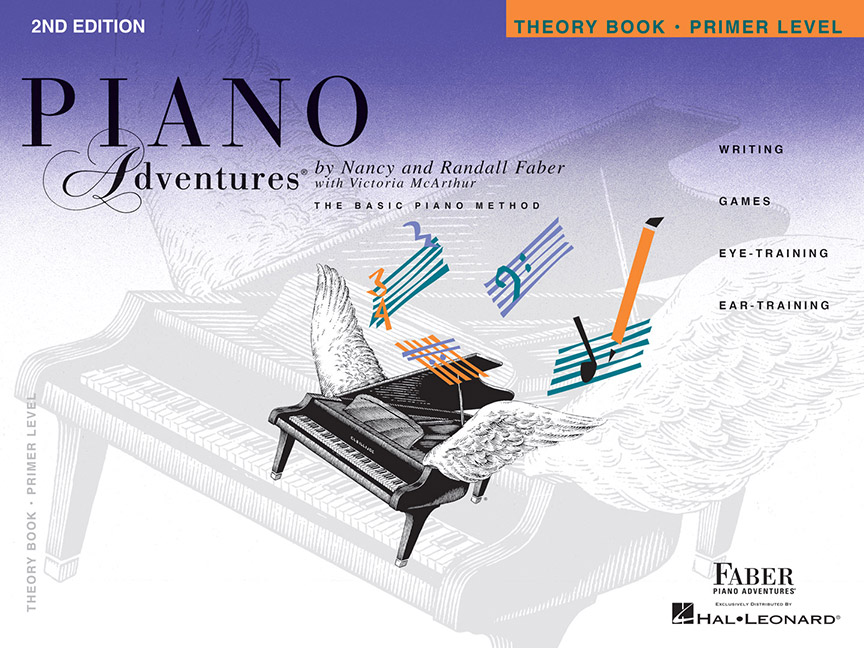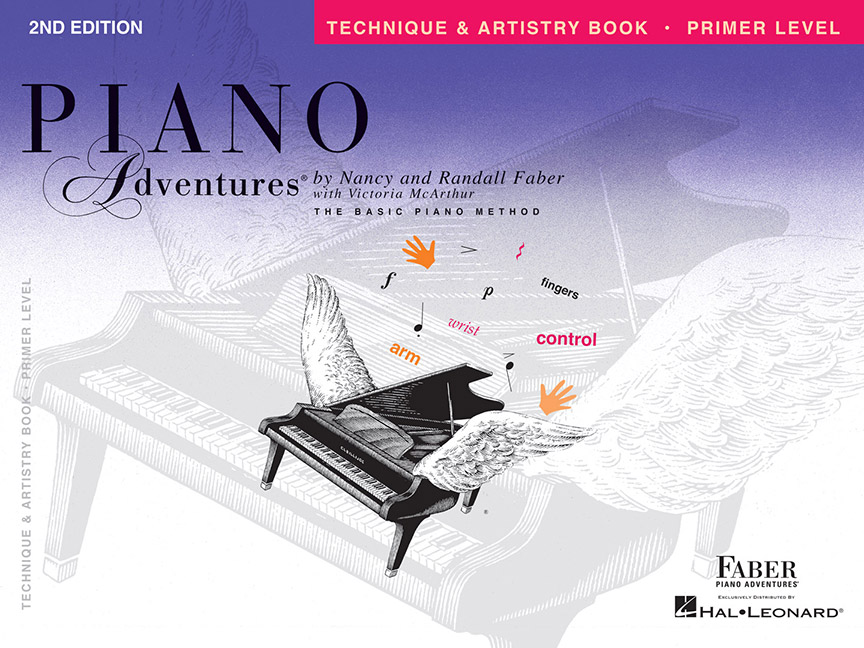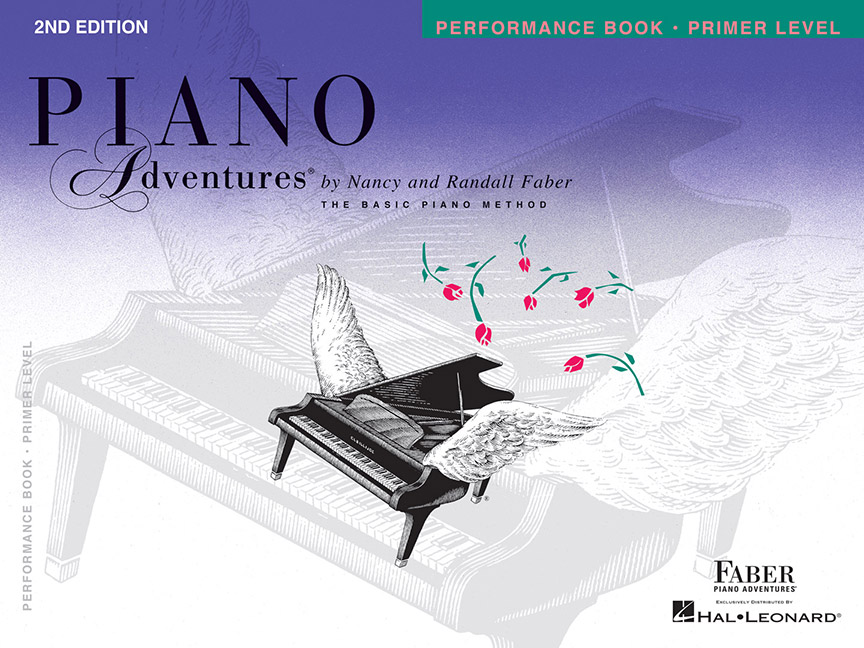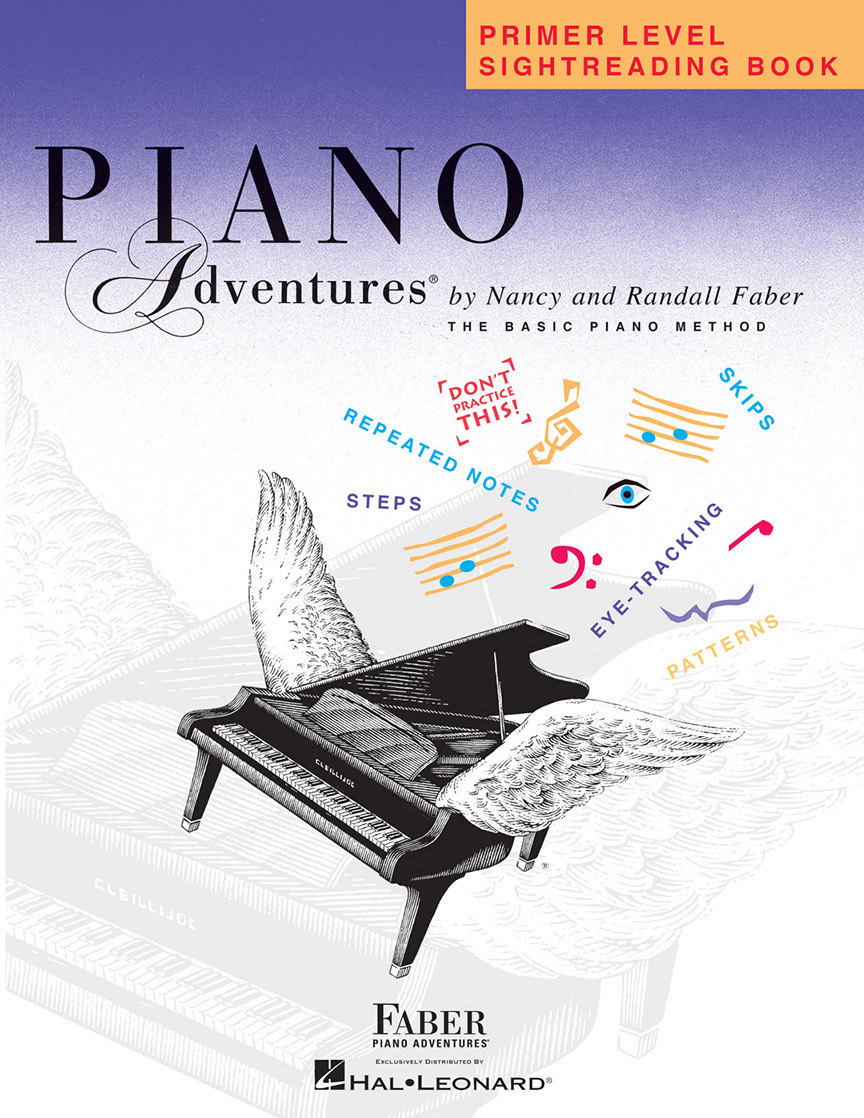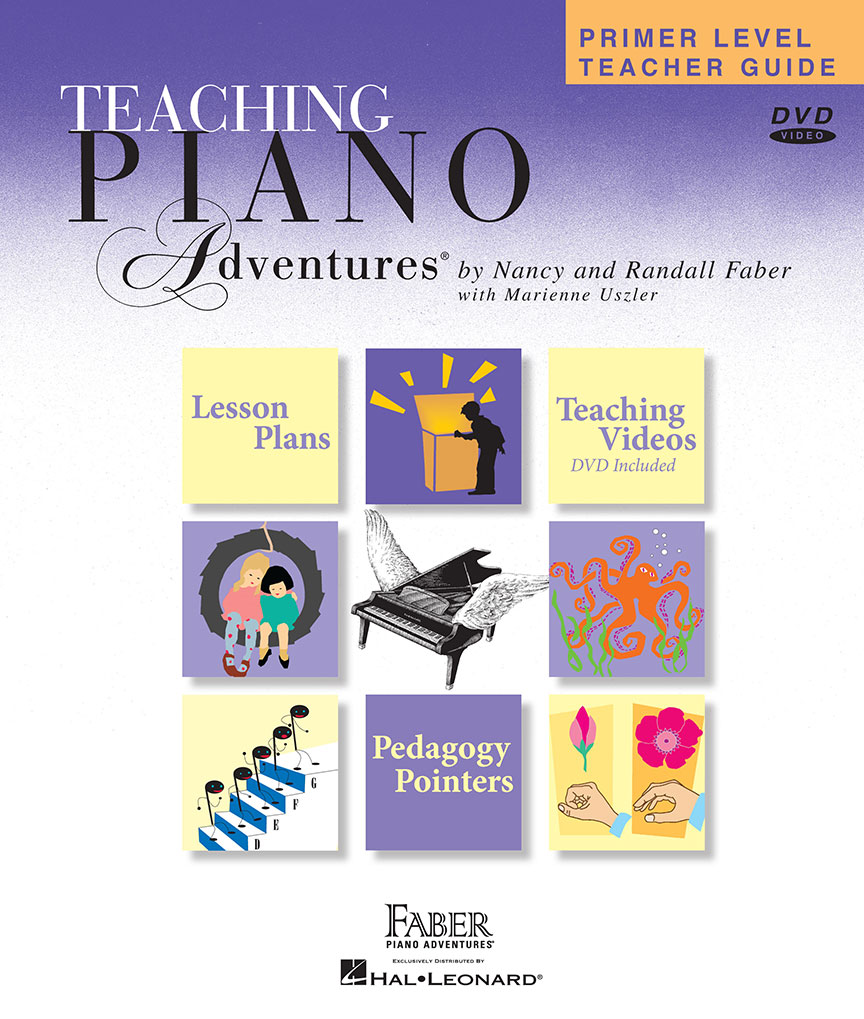
20Questions and Answers for the Primer Level
About the Primer books
- Why are the Primer Books a good way to start?
- What is the best age to start the Primer?
- Do I need to use all four core books; Lesson, Theory, Technique & Artistry, and Performance?
- How do I fit all four core books into a lesson?
- What are the Technique Secrets and how do they help?
- When should I use the Primer Sightreading Book and how?
- How long does it take for a student to complete the Primer?
- What is the Primer Teacher Manual?
About the Primer student
- How long should a lesson be for a Primer student?
- How many songs should a Primer student be assigned each week?
- How long should a beginner practice each day?
- Is it hard for a student to learn to read music? What is the reading strategy for the Primer Level?
- What if a student has a poor sense of rhythm?
- Should a student be memorizing the assigned pieces?
- What pieces/books could Primer students play for extra fun?
- How important are recitals? How can I make them fun?
- Can I teach Primer students online? What are some teaching tips?
About Primer Adventure Learning Videos
About Primer Audio Files
1. Why are the Primer Books a good way to start?
The Primer Books make a good beginning as the materials are designed for wholistic learning. Students learn note names, yes! But they also learn to read by steps and skips as well as recognizing musical patterns. Different ways to decipher the “musical code” create strong music readers.
Students learn songs for correct rhythm, notes, and dynamics, yes! But they also explore improvisation, sightreading, and theory analysis of the songs.
In addition, playing the “ultimate instrument” is made more adventurous with teacher duets and colorful orchestrations for a great ensemble experience—from a jazz band, to “Martian” sounds, to a symphony orchestra.
Wholistic leads to artistic!
2. What is the best age to start the Primer?
The Primer Books are for children ages 6-11. The younger ages take more time to progress through the level while 10 to 11-year-old students can clip through at a good pace.
The books feature sophisticated artwork and the titles span the 6-11 age group well. Sample titles include “My Invention,” “Petite Minuet,” “Princess or Monster?” and the familiar “Yankee Doodle.”
The note size is not a jumbo size but large enough for successful eye tracking and recognition of lines and spaces on the staff.
Most students ages 6-11 will find an engaging path for first lessons.
3. Do I need to use all four core books: Lesson, Theory, Technique & Artistry, and Performance?
The four core Primer Books form a set for wholistic learning and correlate by page number. The Theory, Technique & Artistry, and Performance Books give fresh perspectives for concepts in the Lesson Book. It is possible a teacher could substitute a different solo book than the Performance Book. However, the precise tie-in of concepts with the core books is hard to beat. The beginning student is forming connections—connections that begin to form the musical mind—and the more efficient these connections are made the better.
The core books address things easy to miss in lessons: ear-training, sightreading, improvisation, and importantly, technique from the very first lessons. Taking the time for deeper learning using the four core Primer Books prepares students for success in Level 1.
4. How do I fit all four core books into a lesson?
The three most important books are the Lesson Book, the Theory Book, and the Technique & Artistry Book. A 30-minute lesson allows approximately 10 minutes per book. A 45-minute lesson offers a distinct time advantage for using all four books.
If time is short, consider demonstrating the Performance Book piece while the student watches the score. Give a few pointers, then assign to learn at home as “Your Own Adventure Piece.” This gives the teacher an opportunity to see what is easy and what is challenging at the next lesson.
For the Theory Book, the teacher might do the first example on a page with the student, then assign to complete at home. Parents can often help at the Primer level.
With careful lesson planning and efficient use of lesson time, the four books can be implemented, even if one book is not covered in some lessons.
5.What are the Technique Secrets and how do they help?
Technique at the piano requires more than finger muscles. It involves sophisticated body motion between the body, arm, wrist, and finger. We call these motions “technique gestures.”
At each level of Piano Adventures, the student is introduced to level-appropriate Technique Secrets that promote fluent playing while preventing bad habits. These “secrets” are used as daily warm-ups for the exercises that follow in the book. This combination of secrets and exercises leads to an Artistry Magic Piece at the end of each unit. These pieces allow the young student to demonstrate artistry based on fine technique learned earlier.
The Primer Level has 5 Technique Secrets, each with a unique name.
- Good Posture (Karate Pose)
- Rounded Hand Shape (Blooming Flowers)
- Firm Fingertips (Making 0’s)
- Arm Weight (Heavy Wet Ropes)
- Correct Thumb Position (Thumb Perch)
Check out sample videos of a Primer Technique Secret and Artistry Magic Piece. These and many more are available with a subscription to the Teacher Atlas.
Five Secrets for Piano Technique (pp. 4-5)
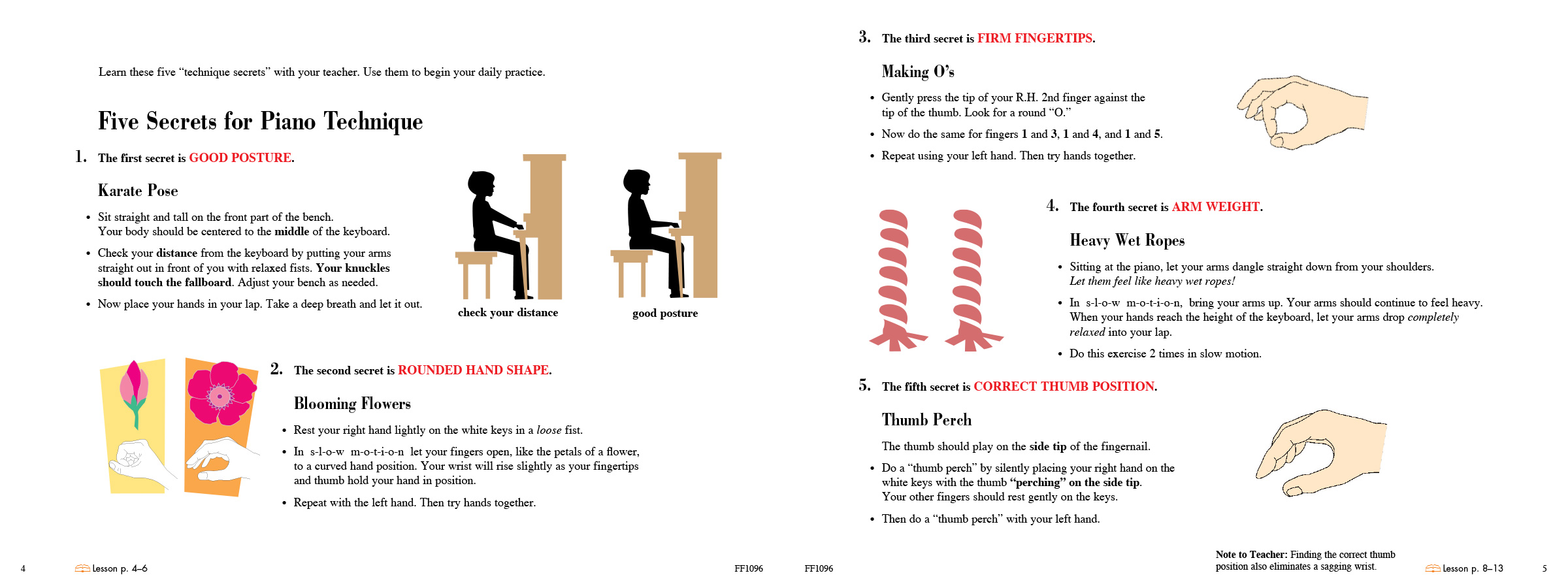
Primer Technique Secret: Firm Fingertips
Primer Artistry Magic Piece: Peaceful Sunset
6. When should I use the Primer Sightreading Book and how?
The Primer Sightreading Book builds confident readers from the very first lessons in two ways: 1) recognition of individual notes, and 2) perception of rhythmic and melodic patterns.
The book is organized into sets of 6 exercises, for 6 days of practice. Each set presents variations on a piece from the Primer Lesson Book. Play one exercise a day, completing one set per week.
Students may begin the Primer Sightreading Book as soon as they learn “Middle C March” (p. 40) in the Primer Lesson Book. Introducing sightreading from the first notes on the staff allows this principle to operate: Notes that do not change their location on the staff are integrated into compositional patterns that do change. Permanence and change coming together for musical literacy!
Here are several ways to use the Primer Sightreading Book.
- Teachers listen to the sightreading example for just “Day 1” at the lesson. Assign the next pages of the 6-day set to sightread at home. At the following lesson, the teacher might choose one sample “Day” from that set to hear. Then assign the next set.
- If teaching 30-minute lessons, teachers might consider using the Sightreading Book in place of the Performance Book.
- Some teachers enjoy using the Sightreading book at the lesson to introduce a new note or piece. The student then learns the correlating Lesson Book piece at home as an independent study.
The Sightreading Book can be used as a final end-of-level project. Before starting Level 1, take several weeks to assign multiple pages of the Sightreading Book, along with a PreTime Book. Students can enjoy a change of pace in their practice routine while celebrating all the notes they have learned.
Primer Sightreading Book
Table of Contents (pp. 2-3)

Middle C March 6-Day Set (pp. 12-15)


7. How long does it take for a student to complete the Primer?
It’s important for students to go at their own ideal pace for successful learning. The teacher is the best person to ascertain “pacing, not racing.”
If there are 10 units in the Primer Lesson Book with students using the 4 core books, a goal might be to complete the Primer Books within the 9-month school year. Some students will complete sooner.
Students can enjoy monitoring their own progress with the Certificate at the end of the Primer Lesson Book (shown below). Here students build their own Certificate through a sticker placed for each song as it is learned. The result is a full display of achievement!
Primer Level Certificate (p. 72)

8. What is the Primer Teacher Manual?
The 2nd Edition Primer Level Teacher Guide provides comprehensive support for instructing beginning students using the Faber ACE (analyze, create, express) teaching system.
Included are updated lesson plans, tips to reinforce concepts and skills, and ideas for creative exploration. Watch Nancy Faber and her young students in over 60 model teaching videos. Reflect with 20 new pedagogy articles and “ask yourself” study questions. And prepare for group activities with new ensemble parts, stories, and extended teacher duets.
The print edition includes the 176-page hardcover Teacher Guide, 64-page softcover Duet Appendix, and a DVD featuring over three hours of video lessons. The Teacher Atlas also includes the Primer Teacher Guide as part of its many offerings.
About the Primer Student
9. How long should a lesson be for a Primer student?
Typically, a lesson is 30 or 45 minutes long. A class lesson might be an hour in length. If possible, a 45-minute lesson is highly recommended for a private lesson. Teachers have time to integrate important concepts spanning the core books, as well as foster the teacher-student relationship so important for the beginning student.

10. How many songs should a Primer student be assigned each week?
There is no firm answer to this, but one interesting “rule of thumb” is to give students the same number of pieces as their age. A 6-year-old student would then have 6 items on the practice sheet.
These items can include 5-finger scales, a theory page, a Technique & Artistry exercise, as well as new and review pieces. Playing review pieces or “just for fun” pieces is helpful as it allows the student to bring the piece to a higher level of performance. It also lets the teacher assign songs to be memorized (ideal to do from the first lessons). Finally, review pieces invite creative ventures, such as making up a new ending to a song.
Many children may be able to do more entries than their age, and this is always encouraged. The teacher might relay, “Your songs this week seemed easy for you. What do you think about taking one or two more pieces this week?” The child’s willingness is also a good marker of how much to adventure on!
11. How long should a beginner practice each day?
The length of practice depends on how much is assigned. Beginners should aim for 15 minutes minimum. If practiced is focused, a lot can be accomplished in 15 minutes! Some students may be able to practice 20 minutes in a sitting or divide the time into two 10-minute sessions.
If students have extra time after completing their practice assignment, there is no substitute for plain old “horsing around” and making up their own sounds and songs.
12. Is it hard for a student to learn to read music? What is the reading strategy for the Primer Level?
Most students find learning to read music somewhat challenging. However, it is similar to learning any skill where progress happens in small steps, each one understood and acquired. Here are steps of how reading is presented in the Primer Lesson Book.
- Pre-reading (directional reading off the staff) comes first. Students quickly become familiar with note movement up, down, or repeating. This sets the stage for moving to the staff.
- On-the-staff reading begins with a set of 3 notes: Middle C, Treble G, and Bass F. These become “guide notes” to help find surrounding notes.
- From here, small groups of notes are introduced systematically.
Treble notes D-E-F as the three notes between Middle C and Treble G.
Bass Clef notes B-A-G as the three notes between Middle C and Bass F.
We now have a 9-note range—with the ability to play many songs!
- At this point, in addition to 9 note names, students are also reading by the simplest of intervals—steps and skips.
- Note reading expands to Bass C (the first C below Middle C) and students learn the term octave. Then Bass notes D and E complete the notes of the C 5-finger scale.
Just using the Lesson Book is not enough to produce a fluent reader. Students need to be reading lots of notes to become comfortable with this new musical language. One of the best ways to form these connections is to use the Primer Sightreading Book. (See Question 6). This book presents fanciful short exercises based on the melodic and rhythmic patterns in the Primer Lesson Book.
Consider also using the Primer Sightreading Book at the end of the Primer as a “final hurrah” to strengthen the student’s note reading ability before moving to Level 1.
Piano Adventures Flashcards are also available and span the Primer through Level 2A.
13. What if a student has a poor sense of rhythm?
If a student has a poor sense of rhythm, there are fun things that can be done.
- First, a teacher wants to be sure the student can keep a steady beat in a simple setting, then a more complex setting. Set the tempo and have the student clap a steady beat while the teacher plays the student piece. Then have the student clap a steady beat while the teacher plays the Teacher Duet to the same song. Simple rhythm to a more complex rhythm.
- Use rhythm instruments to play the rhythm of the song. Many students especially enjoy the xylophone.
- At the Primer Level, most rhythmic errors involve “sailing through” the half notes and whole notes—not giving them their full value. Rather than the teacher writing the counts in, have the student do the writing.
- Playing the Teacher Duets allows students to enjoy an interesting rhythmic background while demonstrating rhythm independence.

14. Should a student be memorizing the assigned pieces?
Primer Level pieces are short—often only 8 measures! Why not play one piece by memory each week, or every two weeks? Chat about the patterns. By starting early, as early as “Two Black Ants” (p. 10) students integrate memorizing as a natural part of playing. With songs so short, they are immediately successful. And success breeds success!
Consider keeping a list of 3-5 pieces a student can play by memory at any time. Then when someone asks them to play, they are prepared to shine.
15. What pieces/books could Primer students play for extra fun?
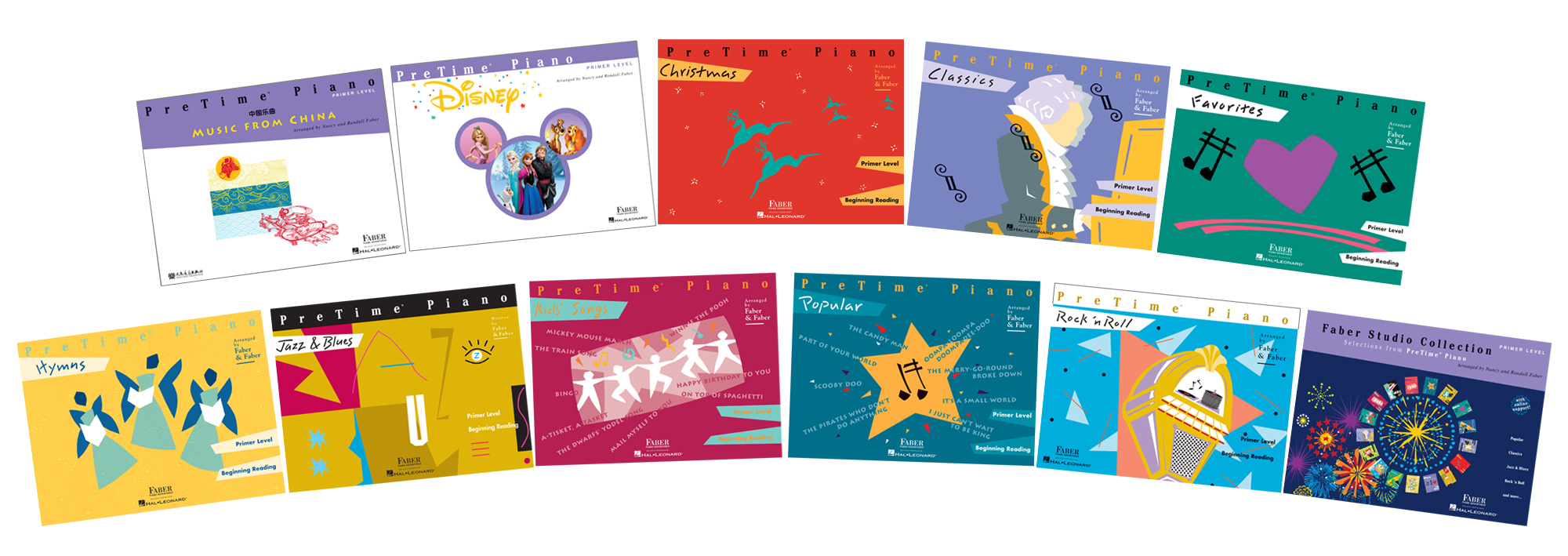
For extra Primer level fun, the PreTime Piano Books offer great repertoire. The PreTime Books have a variety of styles with many familiar songs of 8 to 16 measures. A beginning student could start a PreTime Book at the end of Unit 7 or Unit 8 in the Primer Lesson Book.
PreTime Piano Books provide effective supplementary repertoire in 3 ways:
- They help confirm a clear understanding of basic rhythms.
- They offer great note-reading reinforcement with a limited set of notes.
- They prepare the student for a smooth transition into Level 1.
See books and song titles for the PreTime Piano Books.
Primer students may also enjoy the Primer Gold Star Performance Book (great for recitals) and the Piano Adventures Primer Christmas Book. Various Primer Sheets are also available.

16. How important are recitals? How can I make them fun?
Recitals can be an exciting event for the Primer student. Recitals can also be intimidating. Students will usually remember their first recital. So making it friendly, upbeat, and fun is keenly important.
- Consider calling the recital, “The Piano Party.” Great music, great treats, great fun!
- Consider playing duets with Primer students. Your composure will transfer to the student. Any mistakes can easily be accommodated with the duet.
- As the recital approaches and students are polishing their pieces, have a “practice performance” with the student by sitting across the room. Students practice walking in, seating themselves with hands in lap, thinking the tempo in their head, placing hands carefully in position, and beginning the piece. When done, practice taking a bow, smiling, and leaving the piano.
- “Practice performances” can also be done in a small group session with the teacher. If this is done several weeks before the actual event, a good outcome is almost certain. Poise must be practiced!
- Lastly, as “The Piano Party” begins, consider giving the parents a big “thank you” for supporting their child’s music education. And then cheerfully ask the audience to clap enthusiastically for each performer. Shouting “bravo” is fine!
Practice this with the audience. “Your children have worked very hard this year. Let’s practice clapping for the young performers before we begin. Give it your all. Ready, go!” (Begin the clapping with gusto to set the tone.) Kids will get a big kick out of this and it primes everyone to relax and have a good time. Then the recital can begin.

17. Can I teach Primer students online? What are some teaching tips?
Yes, it is completely possible to teach the core Primer books in an online lesson. The Teacher Atlas makes it especially easy, offering all publications for viewing including the Primer method books and the supplementary PreTime Piano Books. Using your favorite video conferencing app, you can share screens and even annotate to help your student follow along in his or her own copies of the books.
NOTE: Have the student become very familiar with the music page before playing. Accomplish this through questions that require active responses from the student. Keep the discussion light, upbeat, and “congratulatory” as the student answers.
Let’s apply this to the piece below. These are sample ideas. Teachers can create original questions and responses.
Primer Lesson Book
Two Blackbirds (p. 11)
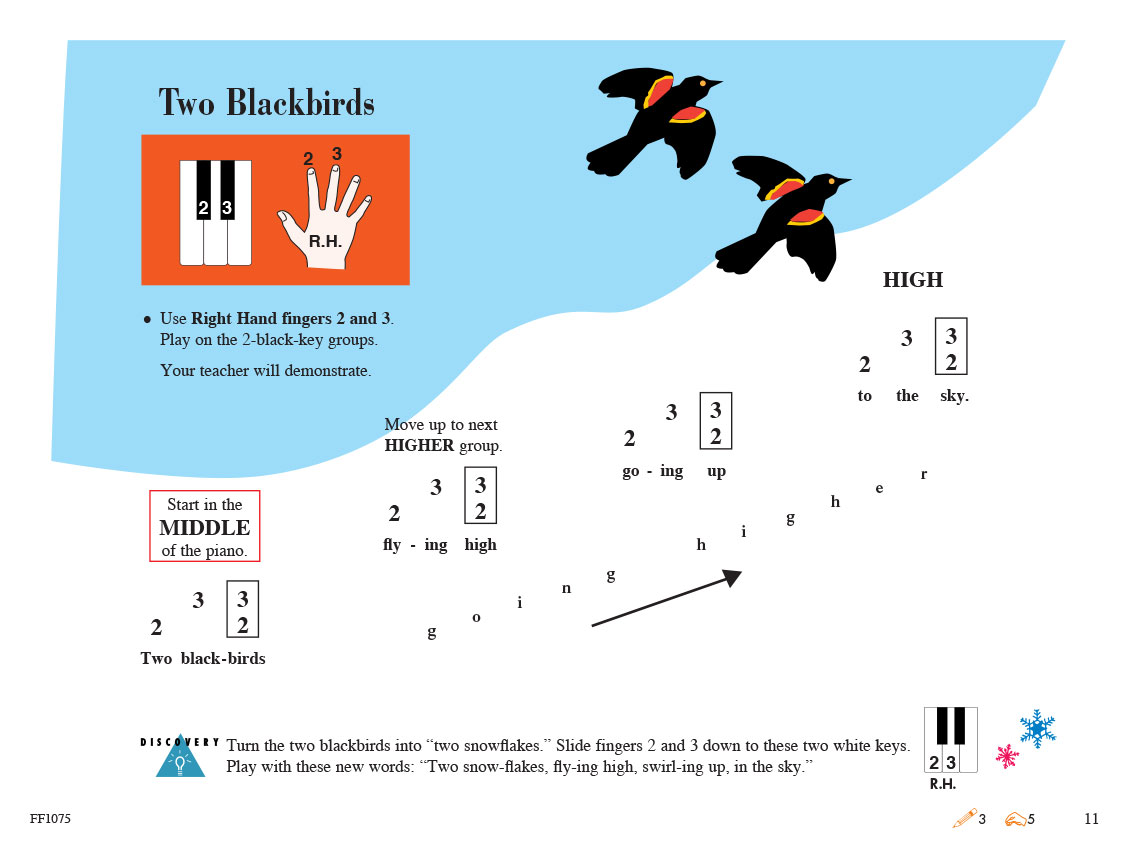
Sample Online Lesson Questions
- What kind of creatures do you see on the page?
“Yes, two blackbirds!”
- Are they flying higher or lower?
“Correct, higher. Let’s learn a song that goes higher up the keys.”
- The hand in the red box shows two finger numbers. What are they?”
“Exactly. Fingers 2 and 3.”
- And does that little keyboard by the hand show 2-black keys or 3-black keys?
“Yes, it’s a 2-black key group.”
- Now look at the bottom of the page. I’m going to circle the numbers 2 and 3 and also the box with the same numbers. One big circle around them all. We could call this a pattern. (Use annotation tool to circle or hold up a book for the student to see.)
“Can you see my circled pattern?”
- Will you make a big circle around that pattern in your own book and show me?
“Excellent.”
- There are 3 more patterns just like this on the page. They each go higher. Can you circle them in your book? Show me on the screen.
“You got it!”
- Now listen to me play the piece. I start in the middle with R.H. fingers 2-3 on the 2-black keys. First, I play the notes alone (play 2-3 separately) and then together (play together.)
I like to say these words, “2-3, together!” (Play as you say.)
- Then my birds fly up to the next 2-black keys and I play the pattern again. (Do.) They fly higher again and I play the pattern. (Do) And one more time, really high to end.
“Could you hear the pattern going higher?”
NOTE: Coming shortly, the teacher could also show the Adventure Learning Video for “Two Blackbirds.” For this, assign the student to scan the QR Code. Copying the hand motions in the video will help the student’s technique.
- Now it’s your turn to play! Show me your starting position on the keys.
About Primer Adventure Learning Videos
18. What are the Adventure Learning Videos?
Led by the musical mascot, “Trophy,” the Adventure Learning Videos help Primer students “go forward faster with fun.” Coming soon, the videos feature animation with close-ups of the hands and simple text. They can be used in a variety of ways for theory analysis, technique tips, and beginning composition.
- The teacher has the student watch a video at home for a piece presented at the lesson. Since the video offers unique practice support, it reminds the student of key musical points for a successful next lesson.
- The teacher may assign a new piece not presented at the lesson. Students “adventure” on their own with independent learning and grow in self-confidence.
- The teacher shares an Adventure Learning Video at an online lesson as a presentation aid.
Sample Adventure Learning Video
Adventure Learning Video
“Let’s Play Ball!” Primer Lesson Book, p. 46
19. What are the Super Student Challenge Videos?
Each piece also includes a “deeper learning video” called a Super Student Challenge (coming shortly). A Challenge might be technical in nature with musical patterns repeated higher or lower for an impressive ending. Trophy may guide an analysis of steps and skips. Or try a Yankee Doodle variation as he loses his hat!
The core idea behind the Super Student Challenges is to enhance creativity, technique, and performance skills—with just the right amount of adventure.
Sample Super Student Challenge Video
Adventure Learning Video
“Let’s Play Ball!” Primer Lesson Book, p. 46
About Primer Audio Files
20. What are the audio files and how could I use them?
Orchestrated accompaniments for Primer pieces are available in the Audio Cloud and Piano Adventures Player app. Have fun exploring with your students!
Preview a track a week before teaching it at the lesson. As you listen together, discuss the sound. Is the piece happy or sad? Is the tempo fast or slow? Can you name one of the instruments that is playing?
Playing with a background accompaniment demands correct rhythm and can be more fun than using a metronome. Students learn to feel the meter and understand the need to “keep going.” Demonstrate with the practice tempo track and point to each note in time, or chant the lyrics, finger numbers, or note names.
Many of the accompaniments encourage free improvisation on the black or white keys. These extra measures offer opportunities to create original sounds.
The musical vignettes in this series introduce the student to a variety of musical sounds and ensembles, such as the marching band, chamber orchestra, jazz ensemble, rock band, and more. Which styles are your favorites?


